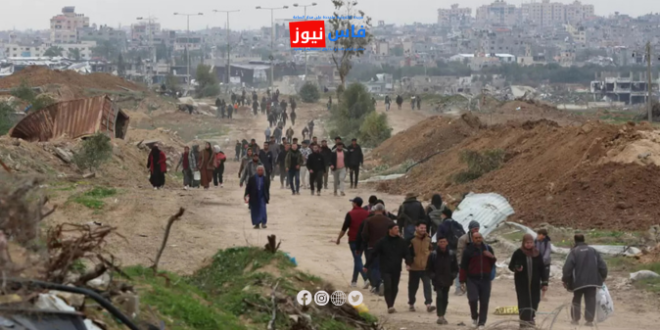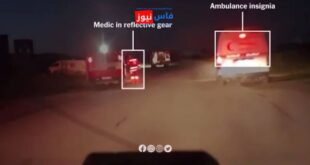On Sunday, the Israeli army completed its withdrawal from the Netzarim Corridor, which divides the Gaza Strip into two parts, allowing free movement between the northern and southern areas of the territory as part of the fragile truce agreement with Hamas.
Immediately after the announcement of the Israeli withdrawal, long lines of cars, trucks, and carts overloaded with luggage formed in both directions amidst a landscape of ruins.
Following a fifth exchange of Israeli hostages and Palestinian prisoners, an AFP journalist on the ground confirmed that Israeli forces had withdrawn from this corridor, established in December 2023. Its reopening at the end of January had already allowed hundreds of thousands of displaced people to return to the northern part of the territory.
A Hamas-run Interior Ministry official told AFP, “Israeli forces dismantled their positions and military posts, with the complete withdrawal of their armored vehicles from the Netzarim Corridor on Salah al-Din Road,” which connects the south to the north of the Gaza Strip, “allowing vehicles to move freely in both directions.”
On Salah al-Din Road, men, women, and children were seen crossing the corridor on foot, linking the east and west of the Gaza Strip, from the Israeli border to the Mediterranean Sea, to return to their homes destroyed by the war.
Osama Abu Kamil, a 57-year-old father, who returned to northern Netzarim after being displaced to the south for over a year, said, “We will set up a tent near the ruins of our house.”
On Saturday, a senior Hamas official told AFP that Israel must withdraw from this passage after the fifth exchange, according to the terms of the truce agreement in effect since January 19 for an initial six-week phase.
In a still tense context, the Civil Defense confirmed that Israeli forces shot three civilians on Sunday in Gaza City, while the army stated it had fired “warning shots” at Palestinians who approached its troops.
Israeli Defense Minister Israel Katz said, “There will be zero tolerance for any threat against army forces.”
The details of the ceasefire agreement, aimed at ending the war triggered by the Palestinian Islamic movement’s attack in southern Israel on October 7, 2023, have not been made public.
This attack resulted in the deaths of 1,210 people on the Israeli side, mostly civilians, according to an AFP tally based on official Israeli data.
In retaliation, Israeli strikes on the Gaza Strip have killed at least 48,181 people, mostly civilians, according to data from the Hamas-run Health Ministry, deemed reliable by the UN.
Of the 251 people kidnapped during the attack, 73 are still held in Gaza, including at least 34 who have died, according to the Israeli army.
On Saturday, three Israeli hostages, visibly emaciated and physically exhausted, were released in a staged event orchestrated by Hamas, in exchange for 183 Palestinian prisoners held by Israel.
Israeli Prime Minister Benjamin Netanyahu described these images as “shocking” and vowed they “will not go unanswered,” reiterating his commitment to “eliminate” Hamas and bring back the remaining hostages.
Hamas, for its part, denounced what it called the “slow killing” of Palestinian detainees in Israeli prisons, after seven of them were hospitalized immediately after their release.
Netanyahu also announced the dispatch of negotiators to Qatar, the main mediating country, to discuss the next steps in the truce.
Meanwhile, Hamas political official Bassem Naim told AFP on Saturday that Israel was “endangering” the ceasefire and warned that it “could collapse.”
On Sunday, five former Thai hostages released by Hamas at the end of January returned to their country, where they were emotionally reunited with their families.
One of them, Pongsak Tanna, exclaimed at the airport, “Finally, we can return to our homeland,” expressing his indescribable joy.
Since the start of the truce, 16 Israeli hostages have been released, along with these five Thais (outside the agreement), in exchange for 765 Palestinian prisoners.
The second phase of the ceasefire is expected to lead to the release of all hostages and a definitive end to the war, followed by a final phase dedicated to the reconstruction of Gaza.
However, the future of the process remains uncertain, especially after US President Donald Trump’s shocking announcement of a plan for the US to take control of Gaza and relocate its population to Egypt or Jordan.
Netanyahu praised this plan, which has faced widespread criticism globally, and stated that Israel is ready to “get the job done” to implement it, in an interview aired on Fox News on Saturday.
Meanwhile, Arab countries, opposed to any forced displacement of Palestinians, are attempting to coordinate a joint response to the US plan.
Egyptian Foreign Minister Badr Abdelatty departed for Washington on Sunday, while US Secretary of State Marco Rubio is expected to visit the Middle East next week.
 فاس نيوز ميديا جريدة الكترونية جهوية تعنى بشؤون و أخبار جهة فاس مكناس – متجددة على مدار الساعة
فاس نيوز ميديا جريدة الكترونية جهوية تعنى بشؤون و أخبار جهة فاس مكناس – متجددة على مدار الساعة













